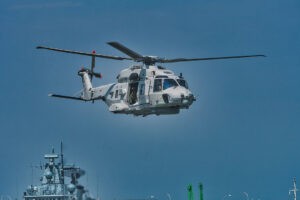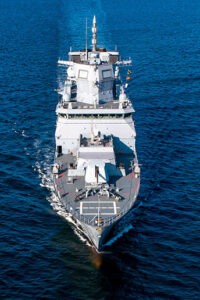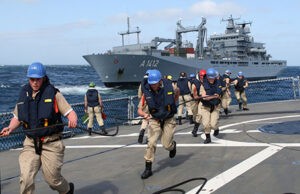The time for downsizing seems to be over in Operational Flotilla 2. The challenges of the future can be mastered with new ships and modern systems.
Operational Flotilla 2 in Wilhelmshaven is the largest operational unit of the German Navy. The frigates assigned to it are the platforms with the broadest spectrum in terms of capabilities, operational areas and components to be organically integrated. The same applies to the associated support platforms.
The resulting range of operational requirements has always meant that the material has always required constant further development and regeneration in order to fulfil the respective requirements of modern operations and prevent obsolescence. Conversely, the age of the inventory in all components means that, despite increased expenditure, operations can only be guaranteed by accepting restrictions. In addition to the direct effects on the organisation, such as the constant need to reschedule sections of operational training and the resulting lack of availability of ships for short-term orders and deployments, it also ties up personnel in the areas of maintenance at all levels, project work and industry.

It is therefore all the more pleasing that a large number of projects for all ship classes and even new ship classes are currently being realised. Some of these, which were introduced into the planning process as part of the Material turnaround, will be coming soon. They will modernise the flotilla's portfolio in the long term. In addition, there is hope that the scope created on the timeline by the German government's 100 billion euro special package will allow further projects and measures to be introduced that will directly benefit the flotilla, including the development of the Class 127 frigates.
Frigates class 123
The four Class 123 frigates were commissioned in the mid-1990s. Their service life was designed for 30 years. As part of an initial service life extension, the period 2027 - 2030 was set for the planned decommissioning. This required extensive shipbuilding measures, for example to increase stability and hull strength, as well as various obsolescence elimination measures in the area of weapon function chains based on the replacement of the Satir command and weapon deployment system (FüWES) with Sabrina 21. Projects such as the replacement of the tactical radar systems, the electronic warfare system, the sonar and the Harpoon maritime target missile system with the Naval Strike Missile 1A and the integration of the Rolling Airframe Missile (RAM) 2B and Evolved Sea Sparrow Missile (ESSM) missiles were therefore planned. After the FüWES manufacturer cancelled its cooperation in the integration of the new radar systems, the ship class had to be reassessed. Due to the financial planning framework conditions, a ministerial decision was made at the end of 2020 to summarise the measures required for the usability of the units in an overall package entitled Ensuring Operational Availability (SdEV), subject to the proviso of a second service life extension until 2032 or 2035, i.e. until the operational availability of the Class 126 units.
As a result, the four units are now being comprehensively modernised. The measures include the sensor technology, the weapon function chains and most of the weapon systems. Only the 76-millimetre gun will remain on board in its current configuration. The measures required for accreditation are being carried out in parallel. Basically, this modernisation corresponds to a complete redesign of the ship's electronics and weapons technology. In addition, recognised damage to the platform will also be repaired during the depot overhaul required for implementation. Once the measures have been completed, the armoury will be designated as class 123B.
The units will be equipped to bring their core capabilities to bear in the system network in a threat-appropriate and modern manner. The modern hydroacoustic sensor suite, in which a towed array system and sonar buoy evaluation are permanently integrated for the first time, should be emphasised. This is a quantum leap in terms of creating an underwater and surface image. It will also have very strong commonality with the future Class 126. Integration of the NH 90 as the successor to the Sea Lynx Mk 88A shipboard helicopter will not be realised due to the insufficient size of the hangars. Partial compensation of the on-board helicopter's capabilities by an unmanned system is being examined.

Starting with the frigate SCHLESWIG-HOLSTEIN, the conversion is already underway and is scheduled to be completed for all four ships in 2026: After that, they will be available to Operational Flotilla 2 for the rest of their service life without any further major measures.
Frigates class 124
The three Class 124 units are in a similar starting position to the Class 123 units: commissioned between 2004 and 2006 and with a planned service life until the mid-thirties, they are around ten years younger, but several sensors and effectors still need to be replaced. Technological advances in threats, such as hypersonic missiles, are particularly relevant for the main task of air defence and are reflected in the complexity and time requirements of the functional chains. For this reason, the integration of new missiles equivalent to class 123 is also planned for these units in the next maintenance phases. The regeneration of capability-defining sensors is also planned for the second half of the current decade: The long-range radar will be replaced by a rotating TRS-4D LR, which is almost identical in design to the replacement for the Air Force's Hughes Air Defence Radar (HADR) systems. Measures are also being carried out on the Active Phased Array Radar (APAR). The electronic warfare system will also be modernised.
In addition, the integration of the Sea Tiger helicopter, the replacement of the sea target missile system and the elimination of obsolescence and regeneration of various smaller systems and equipment are also planned. As a result, the Class 124 will also be significantly upgraded by the end of the decade in order to be available with an improved capability portfolio for the remainder of its service life.
Due to the unique nature of the German Navy's air defence capability, it is particularly important to maintain this capability without interruption in response to threats. Timely planning and implementation of the succession planning already initiated for the 127 class is therefore essential. A further extension of the service life of Class 124 would not be realisable without extensive measures that need to be defined in the near future.

Frigates class 125
The four Class 125 units form the most modern frigate system. The realisation of the infrastructure-related parts of the Multidimensional Maritime Warfare Training Centre (EAZ MD SKF) is still pending for the intended operation of the entire Class 125 system. Nevertheless, operations will begin in 2023, initially for the United Nations Unifil mission. Class 125 will play a particularly important role in fulfilling the German Navy's operational obligations over the next few years during the modernisation of classes 123 and 124.^
Frigates class 126
New ships will be introduced with the Class 126, which should be available for training and operational use at the beginning of the 1930s. Firing will start this year and handover to the public client is planned for 2028.
As things stand at present, the overall Class 126 frigate system will consist of four ships, the core crews, the embarkation components such as shipboard helicopter or shipboard deployment teams, the mission modules such as the Towed Array or MCM toolbox components including the associated personnel, system-specific components for the multidimensional naval warfare training centre and class-specific support elements in the staff. All of these components require very close dovetailing, as they are very precisely coordinated not only organisationally but also technically. To this end, all parts except the embarkation components were already considered and contracted in an integrated manner in the project essay. Fine-tuning this overall structure in terms of organisation, procedures and internal processes will certainly still be a challenge, especially as the focus on national and alliance defence has become even stronger compared to the time of the project essay. However, the system also offers the opportunity, for example with synthetic team training through to whole crew training, to completely reorganise operational training and make it less influenced by the maintenance of the ships, which will make it easier to plan and therefore more efficient.
Task force provider class 702
The class 702 task force supply vessels were put into service in 2001, 2002 and 2012. Their intensive use, including as lone operators in missions, has led to the need for extensive material modernisation and adaptation. As part of the modernisation, the NH 90 Sea Lion on-board helicopter will be integrated and the integrated Marine Emergency Rescue Centre (iMERZ) will be installed on the units of the first batch. This iMERZ is now permanently installed on board and expands the portfolio of medical services.
In addition, the radar, the command and control system and the guns are currently being examined to see how they can be modernised or modified in order to safeguard operations. This is to take place in the second half of this decade.
Naval fuel supplier class 707
The project to procure two Class 707 units to replace the SPESSART and RHÖN fuel transporters, which are almost 50 years old, is being implemented: firing began in June of this year and the units are scheduled to be delivered in 2025 and 2026.

with the EGV FrankFurt am main, Photo: Bw/Ann-Kathrin Fischer
Modern safety and environmental standards will be realised in the construction of these new ships, including the double-hull principle. They will also have an alternative diesel-electric drive and a platform automation system. The resulting power management system will also incorporate the now electrically operated RAS system from the outset. Other new features include an embarkation capacity for 23 people, four integrated heavy machine gun weapon stations, bullet protection for essential rooms and a medical area.
Conclusion
Even if, as mentioned at the beginning, no major projects are directly earmarked for Flotilla 2 in the federal government's special fund, numerous modernisation projects will be implemented that will lead to the maintenance and expansion of the capability portfolio. They will have an impact on all planning categories and project elements. It is foreseeable that after years of a widening gap between operational tempo and declining material operational readiness, the trough has almost been reached. The availability of materially operational units of Operational Flotilla 2 will improve significantly over the next few years. Looking ahead to the end of the decade, the planned number of units in training and operational readiness will be sufficient to achieve the target margin of Route 66. In addition to the quantitative availability, the capability portfolio of the units will also improve and expand over the next few years. Existing units will be optimised through the modernisation of sensors and effectors, new units are expected and new capabilities will be acquired. The modern equipment of the units will increase their combat effectiveness and thus their operational value.
NN









One Response
It's a shame that this informative article comes across in such pompous technocratic language. Is this the new ministerial officialese, or even the specialised jargon of the procurement sector? The pleasing facts and the annoying deficits can be expressed much more simply. How about a training course? German language
says Uwe Jenisch